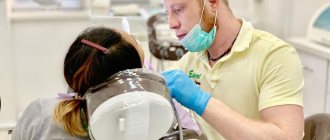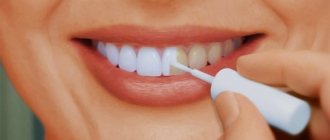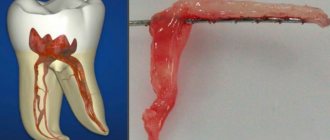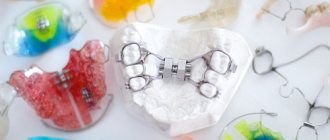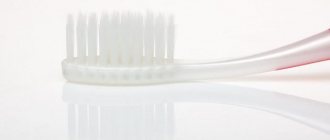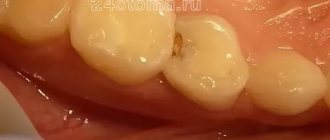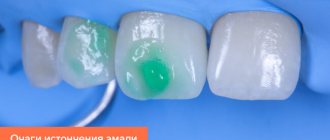Among the many procedures to preserve the beauty and health of teeth, fluoridation occupies a special place. Lack of fluoride or calcium in the hard tissues of teeth leads to their softening, demineralization and destruction. To increase tissue hardness, the tooth surface is treated with a fluoride-containing compound.
The fluoridation procedure is performed for medical reasons; many dental specialists do not recommend doing it for cosmetic purposes. Can everyone's teeth be fluoridated? Does this procedure need to be repeated? How do pregnant women and children tolerate fluoridation? These and other questions are answered by the chief physician, the primary care doctor of the “All Yours!” network of dental clinics. Alexander Korostelev.
What is dental fluoridation?
Fluoridation is a dental procedure during which fluoride preparations are applied to the crown of the tooth. Penetrating deep into the enamel, they saturate it with fluoride.
Why do you need to coat your teeth with fluoride?
Coating teeth with fluoride has a beneficial effect on the condition of enamel and teeth in general. The procedure does not cause pain, takes a minimum of time and gives the following results.
- Prevention of caries.
- Reduced tooth sensitivity.
- High resistance to acid-forming bacteria.
- Strengthening tooth enamel.
- Dentin protection.
To maintain the achieved effect, teeth need to be fluoridated 1 – 2 times a year.
Competitive advantages of dental electrophoresis
- Painless
The procedure takes place in a comfortable environment. A slight tingling sensation is possible, but it is well tolerated by both young and adult organisms.
- Efficiency
You will feel a positive result after the first session. Inflammatory processes inside the dental canal, as well as in the tissues surrounding the apex, are quickly relieved. After the procedure, regeneration processes in the body are noticeably activated.
- Spot impact
Thanks to the procedure, the medicine gets directly into the pathological focus: dental pulp, dentin, dental canal, enamel tissue, periodontium (in case of obstruction of the root canals). This technique is much more effective than the usual use of drugs.
- Minimal risk
The procedure is completely safe, has a minimum of restrictions, and does not cause irritation inside or outside the tissue. The maximum that can happen is slight redness after the procedure, which will go away in 30 minutes.
- Cumulative effect
Positive changes occur with a cumulative effect. Ion exchange inside cells is improved, microcirculation in cell membranes improves. Electrophoresis can effectively restore tooth enamel, improve blood supply to teeth, and remove and treat inflammation.
At the Zuub.rf clinic you can take a course of dental electrophoresis using modern equipment. The specialist will select the most effective composition of medications and, in a few sessions, will help solve a specific problem with the soft and hard tissues of the oral cavity.
If you have the symptoms described in this article, be sure to make an appointment at our clinic.
Don't self-medicate! Even the smallest problem, if not treated correctly, can significantly complicate your life.
By contacting us, you can be sure that:
- Get high-quality and free consultation .
- You will receive the best prices for treatment and the opportunity to receive a special promotional price.
- Only modern equipment and materials will be used.
- You will be treated by professional doctors with many years of experience.
- We offer treatment on credit or in installments. There is also the possibility of obtaining a tax deduction.
- We work seven days a week and without a lunch break, from 9 a.m. to 10 p.m.
+7 (495) 132-02-96
Make an appointment
Types of fluoridation
There are two methods of treating teeth with fluoride – superficial and deep fluoridation.
- Superficial (simple) fluoridation – coating the visible surface of the tooth with fluoride-containing varnish. The procedure is similar to applying manicure polish. To achieve the maximum effect of saturating the enamel with fluoride, it is repeated several times. An alternative to simple fluoridation is the use of trays filled with a fluoride-containing drug. The mouth guards are placed on the upper and lower rows of teeth and kept in place for 10 to 15 minutes. A few days later the procedure is repeated.
- Deep fluoridation - the method involves the use of an enamel-sealing preparation with a high fluoride content. It is applied to the surface of the teeth and left for several minutes. After this, the oral cavity is dried, and the enamel is treated with a special alkaline liquid. The reaction that occurs at this moment leads to the formation of fluoride compounds, which remain in the tooth enamel for 12 to 18 months.
Important! Deep fluoridation is carried out only in dentistry, under the direct supervision of a specialist. This method is 5 times more effective compared to surface treatment.
You can find out more detailed information about the enamel fluoridation procedure on our website.
Features of electrophoresis for teeth
The procedure is performed in a treatment room and is comfortable and painless. Allows you to quickly relieve pain in the tissues, inside the dental canal, thereby eliminating foci of infection. Medicines are administered slowly, and the therapeutic effect lasts for several weeks. The risk of developing allergic reactions is minimal.
Medicines used in electrophoresis:
- lidocaine;
- iodine;
- vitamin cocktails;
- calcium;
- a nicotinic acid;
- novocaine, etc.
Purified water, dimexide, and buffer compounds are used as solvents.
Drug electrophoresis in dentistry is performed as follows:
- a special pad is wetted in the medicinal composition;
- the element is fixed at the site of inflammation;
- when treating pulpitis, the teeth are pre-treated and the drug is simultaneously injected into the canals;
- the tissues of the oral cavity are exposed to weak current pulses through the pad;
- The patient is given an electric current with a gradual increase in strength until painful sensations appear. Thus, the optimal indicator of the power of impact on the zone is determined;
- the procedure lasts about 10 – 30 minutes.
The average duration of an electrophoresis course is 10-20 procedures, which are performed daily or with breaks of one or two days.
Stages of the procedure
The procedure necessary for everyone is carried out in several stages.
- Sanitation of the oral cavity.
- Professional teeth cleaning.
- Drying the oral cavity with a stream of warm air.
- Application of fluoride-containing preparations.
- Additional enamel treatment (in case of deep fluoridation).
All dentist procedures are non-invasive and comfortable for the patient.
Important! Fluoridation is carried out only after sanitation of the oral cavity and hygienic brushing of teeth. Otherwise, the procedure is impractical.
Target
The purpose of this procedure is to restore the balance of mineral composition in the deep layers of the tissues of baby teeth by saturating them with fluoride. Thanks to this procedure, the child’s crowns better resist the effects of bacteria and tolerate exposure to acidic environments .
Fluoridation helps stop the process of tooth decay and the spread of caries to other crowns. In addition, the sensitivity of the enamel is significantly reduced.
What not to eat or drink after fluoridation
After treating enamel with special fluorine-containing compounds, it is recommended to adhere to the following recommendations.
- In the first 3 to 5 hours, refrain from eating food, hot and cold drinks.
- For 1 day, do not take excessively hard foods or foods high in acids.
These restrictions make it possible to maintain the integrity of the thin layer of fluoride and ensure deep penetration of the element into the enamel.
If deep fluoridation was carried out, then you can drink and eat immediately.
Reviews
The fluoridation procedure has a lot of positive reviews, where parents especially note the absence of new foci of carious lesions and a decrease in tooth hypersensitivity. At the same time, children do not change their lifestyle and habits.
We invite everyone whose child has undergone a fluoride remineralization procedure to share their opinion about this in the comments to this article.
If you find an error, please select a piece of text and press Ctrl+Enter.
Tags: childhood caries prevention fluoridation
Did you like the article? stay tuned
Is fluoridation necessary?
Fluoridation is an effective method of caries prevention. It is recommended for adults and children of any age. Among the advantages and disadvantages of the procedure, the following points can be highlighted.
Advantages
- Teeth react less to hot, cold and other irritants.
- Tooth enamel becomes stronger and more attractive.
- A sufficient supply of fluorine protects the structure of fluorapatites from destruction and prevents the leaching of calcium.
Flaws
- The development of fluorosis is a chronic disease of the enamel caused by an excess of fluoride.
To avoid an excess of fluoride in the body, after fluoridation you should stop using fluoride-containing toothpaste. The procedure should not be overused - it can be performed no more than 1 - 2 times a year.
Experts' opinion
More and more specialists prefer fluoridation of children’s dental tissue. Firstly, there are many methods for use, from which you can choose any that suits the required indications and age.
Secondly, fluoridation is the most effective way to restore enamel. Thirdly, the method does not harm the child’s body and does not require the use of special care products.
We recommend watching a video in which a well-known specialist in the treatment of childhood diseases, Dr. Komarovsky, expresses his opinion on fluoridation:
Indications and contraindications
Treatment of enamel with fluoride is especially effective at an early age - at the stage of mineralization and maturation of teeth. It is recommended for older patients as an effective prevention of dental pathologies. Fluoridation is especially important in the following cases.
- Increased sensitivity of enamel.
- Development of caries.
- Abuse of foods high in sugar and acids.
- Previously performed dental, orthopedic, otodontic treatment.
- After professional teeth cleaning.
Patients who live in areas with insufficient fluoride content in regular tap water should pay special attention to fluoridation.
There are only two contraindications to the procedure.
- High fluoride content in tap water.
- Individual intolerance to fluoride preparations.
Before fluoridation, consultation with your doctor and a dentist is necessary.
Where to do it and how much it costs
You can perform remineralization in any clinic near your place of residence or go to private dentistry. If fluoridation is carried out in clinics in Moscow and St. Petersburg, then for 1 tooth you will need to pay 50-100 rubles. The total amount for treatment will be 1500-3000 rubles. It all depends on the clinic, its level and location.
If you seek help from the district dentistry at your place of residence, then doctors should perform dental fluoridation free of charge under your insurance policy. Some district dentists perform the first procedure for free, and then charge money for repeated services.
Fluoridation of teeth at home
Fluoride preparations are available at pharmacies without a prescription. They can be purchased for independent use at home.
The drug Fluorlak, a medicinal product for topical use and caries prevention, has proven itself well. It is used according to the manufacturer's instructions. But the problem is that Fluoride Lac is effective only if plaque and deposits are thoroughly removed - i.e. after professional teeth cleaning. Therefore, it is impossible to avoid visiting the dentist.
Another option for home fluoridation is the use of fluoride toothpastes. Their regular use allows you to compensate for fluoride deficiency and saturate the enamel with the necessary element.
Important! It is not recommended to use fluoride toothpastes on a regular basis. Their regular use can lead to an excess of fluoride in the body. If you use one type of paste, it is better to replace it with a product with a different composition.
Dry cleaning
For professional hygiene, a special gel containing acid and hydrogen is applied to the teeth. The composition is kept for several minutes. Under the influence of chemicals, tartar is destroyed. It is then easily cleaned off with water.
The technique is painless and effective, but plaque in the interdental spaces cannot be removed in this way. The composition also has an adverse effect on the gums, so it is better not to use it for people with closely located vessels.
Mechanical teeth cleaning
The simplest method of professional dental hygiene. It is carried out using dental instruments, highly active pastes and brushes. This takes longer than other cleaning methods. There is a risk of damage to the enamel. Therefore, the mechanical method is used quite rarely.
Fluoridation of teeth
After professional cleaning, teeth are often fluoridated. It performs 4 functions:
- strengthens enamel;
- reduces tooth sensitivity;
- slows down the growth of bacteria;
- reduces the negative impact of an acidic environment.
To do this, the surface of the teeth is coated with fluoride varnish. To do this, use a special brush or mouth guard with gel.
Is it possible to do fluoridation for children and pregnant women?
It is possible and necessary! At an early age and during pregnancy, fluoridation demonstrates the greatest effectiveness. The presence of a sufficient amount of fluoride ensures complete mineralization and maturation of the teeth of the child and fetus.
Do not forget that fluorine is a very toxic and aggressive substance that requires careful handling. Self-use of fluoride-containing medications can be harmful to the child, pregnant woman and fetus. In childhood and during pregnancy, fluoridation is trusted exclusively to specialized specialists - dentists.
Fluoridation of baby teeth
Most parents are sure that since baby teeth are temporary and will be replaced by permanent teeth, they should not be treated or fluoridated. This is a completely wrong judgment! Weakened enamel will inevitably be susceptible to caries. In turn, untreated caries will lead to the development of complications - pulpitis (inflammation of the internal tissues of the tooth) and periodontitis (infectious inflammation of the connective tissue of the dentofacial apparatus).
We should not forget that weakened milk teeth begin to fall out ahead of time, which disrupts the natural process of formation of the rudiments of permanent units. This can lead to bite pathologies, the formation of diastemas, and three.
If indicated, the child’s baby teeth are subject to mandatory fluoridation. The children's procedure is carried out similarly to the adult treatment - following the same protocol and frequency.
Why strengthen baby teeth if they are about to fall out?
“Many parents, unfortunately, think so,” complains Dr. Korostelev. - But you also need to take care of baby teeth. If you lose a baby tooth early, you may have problems with your bite in the future. Also, if a baby tooth has an inflammatory process, this can be transmitted to the permanent tooth, to the follicle of the permanent tooth. This can lead to serious problems, including loss."
Therefore, it is necessary to carry out fluoridation of baby teeth, as well as to strengthen them.
What is the difference between fluoridation and remineralization?
Remineralization is a dental procedure aimed at saturating tooth tissue with useful elements - fluorine, calcium, phosphorus. During its implementation, the visible surface of the teeth is treated with special varnishes, gels, pastes or solutions with a high content of these elements. Penetrating into the tooth tissue, they contribute to their strengthening and healing.
Both fluoridation and remineralization are considered effective methods of prevention. In the first case, it is protection against caries and enamel destruction, and in the second, it is an improvement in the general condition of the teeth. The mechanism of the procedures is similar in both cases.
Indications for the use of electrophoresis in dentistry
- periodontitis;
- pulpitis;
- glossalgia;
- glossitis;
- purulent and inflammatory diseases of the oral cavity;
- dental cysts;
- dental granulomas;
- pathology of the facial nerve;
- inflammation of dental cells (alveolitis);
- lesions of the oral mucosa;
- severe pain after treatment or tooth extraction.
Despite the rapid development of technology in dentistry, electrophoresis has been and remains one of the most effective and affordable physiotherapeutic methods for treating hard and soft dental tissues.
FAQ
Question
— What is the price of dental fluoridation?
Answer
— The cost of the procedure depends on the chosen method (regular or deep fluoridation) and on the drug used. Fluoride varnishes produced in the CIS countries are cheaper than imported analogues. To cover one tooth with varnish you need approximately 50-400 rubles, and for deep fluoridation you will need to pay from 120 to 600 rubles per tooth.
Question
— At what age can the procedure be used for children?
Answer
— The main criterion for performing the procedure on a child is his ability to sit with his mouth open for about 15 minutes. Children as young as six are already capable of this, but there are exceptions. The procedure for strengthening the enamel of baby teeth is very important, as well as during the period when they are replaced by permanent ones or in cases of severe sensitivity.
Question
— How to carry out fluoridation at home and is it harmful?
Answer
— The procedure is absolutely harmless, it is only important to entrust it to a good specialist who will follow all the instructions of the manufacturing companies. Ingestion of the solution during the procedure is prevented by a saliva ejector. But you cannot use professional preparations at home, because they can damage the mucous membrane or be swallowed.
Question
— Is fluoridation inferior to silver plating?
Answer
— Fluoridation has more than one advantage over silver plating. It does not change the color of tooth enamel, whereas silver plating turns them black, which cannot be removed. In addition, with silvering, the development of caries stops, and with fluoridation, it is prevented by strengthening the enamel. But for the treatment of caries, fluoride enrichment can be used only at the initial stage of the disease.
Question
— How often should the procedure be performed?
Answer
— With deep fluoridation, it is enough to repeat it once every 1-2 years, usually it is better to do it at least once every six months.
